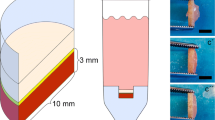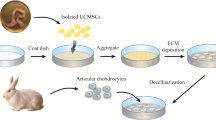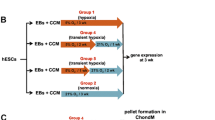Abstract
Regenerative medicine-based approaches for the repair of damaged cartilage rely on the ability to propagate cells while promoting their chondrogenic potential. Thus, conditions for cell expansion should be optimized through careful environmental control. Appropriate oxygen tension and cell expansion substrates and controllable bioreactor systems are probably critical for expansion and subsequent tissue formation during chondrogenic differentiation. We therefore evaluated the effects of oxygen and microcarrier culture on the expansion and subsequent differentiation of human osteoarthritic chondrocytes. Freshly isolated chondrocytes were expanded on tissue culture plastic or CultiSpher-G microcarriers under hypoxic or normoxic conditions (5% or 20% oxygen partial pressure, respectively) followed by cell phenotype analysis with flow cytometry. Cells were redifferentiated in micromass pellet cultures over 4 weeks, under either hypoxia or normoxia. Chondrocytes cultured on tissue culture plastic proliferated faster, expressed higher levels of cell surface markers CD44 and CD105 and demonstrated stronger staining for proteoglycans and collagen type II in pellet cultures compared with microcarrier-cultivated cells. Pellet wet weight, glycosaminoglycan content and expression of chondrogenic genes were significantly increased in cells differentiated under hypoxia. Hypoxia-inducible factor-3α mRNA was up-regulated in these cultures in response to low oxygen tension. These data confirm the beneficial influence of reduced oxygen on ex vivo chondrogenesis. However, hypoxia during cell expansion and microcarrier bioreactor culture does not enhance intrinsic chondrogenic potential. Further improvements in cell culture conditions are therefore required before chondrocytes from osteoarthritic and aged patients can become a useful cell source for cartilage regeneration.






Similar content being viewed by others
References
Aroen A, Loken S, Heir S, Alvik E, Ekeland A, Granlund OG, Engebretsen L (2004) Articular cartilage lesions in 993 consecutive knee arthroscopies. Am J Sports Med 32:211–215
Barbero A, Grogan S, Schafer D, Heberer M, Mainil-Varlet P, Martin I (2004) Age related changes in human articular chondrocyte yield, proliferation and post-expansion chondrogenic capacity. Osteoarthritis Cartilage 12:476–484
Benya PD, Shaffer JD (1982) Dedifferentiated chondrocytes reexpress the differentiated collagen phenotype when cultured in agarose gels. Cell 30:215–224
Binette F, McQuaid DP, Haudenschild DR, Yaeger PC, McPherson JM, Tubo R (1998) Expression of a stable articular cartilage phenotype without evidence of hypertrophy by adult human articular chondrocytes in vitro. J Orthop Res 16:207–216
Borg DJ, Dawson RA, Leavesley DI, Hutmacher DW, Upton Z, Malda J (2009) Functional and phenotypic characterization of human keratinocytes expanded in microcarrier culture. J Biomed Mater Res A 88:184–194
Chomczynski P, Mackey K (1995) Short technical reports. Modification of the TRI reagent procedure for isolation of RNA from polysaccharide- and proteoglycan-rich sources. Biotechniques 19:942–945
Coimbra IB, Jimenez SA, Hawkins DF, Piera-Velazquez S, Stokes DG (2004) Hypoxia inducible factor-1 alpha expression in human normal and osteoarthritic chondrocytes. Osteoarthritis Cartilage 12:336–345
Daouti S, Latario B, Nagulapalli S, Buxton F, Uziel-Fusi S, Chirn GW, Bodian D, Song C, Labow M, Lotz M, Quintavalla J, Kumar C (2005) Development of comprehensive functional genomic screens to identify novel mediators of osteoarthritis. Osteoarthritis Cartilage 13:508–518
Dehne T, Karlsson C, Ringe J, Sittinger M, Lindahl A (2009) Chondrogenic differentiation potential of osteoarthritic chondrocytes and their possible use in matrix-associated autologous chondrocyte transplantation. Arthritis Res Ther 11:R133
Diaz-Romero J, Gaillard JP, Grogan SP, Nesic D, Trub T, Mainil-Varlet P (2005) Immunophenotypic analysis of human articular chondrocytes: changes in surface markers associated with cell expansion in monolayer culture. J Cell Physiol 202:731–742
Diaz-Romero J, Nesic D, Grogan SP, Heini P, Mainil-Varlet P (2008) Immunophenotypic changes of human articular chondrocytes during monolayer culture reflect bona fide dedifferentiation rather than amplification of progenitor cells. J Cell Physiol 214:75–83
D'Ippolito G, Diabira S, Howard GA, Roos BA, Schiller PC (2006) Low oxygen tension inhibits osteogenic differentiation and enhances stemness of human MIAMI cells. Bone 39:513–522
Dorotka R, Bindreiter U, Vavken P, Nehrer S (2005) Behavior of human articular chondrocytes derived from nonarthritic and osteoarthritic cartilage in a collagen matrix. Tissue Eng 11:877–886
Egli RJ, Bastian JD, Ganz R, Hofstetter W, Leunig M (2008) Hypoxic expansion promotes the chondrogenic potential of articular chondrocytes. J Orthop Res 26:977–985
Farndale RW, Sayers CA, Barrett AJ (1982) A direct spectrophotometric microassay for sulfated glycosaminoglycans in cartilage cultures. Connect Tissue Res 9:247–248
Farndale RW, Buttle DJ, Barrett AJ (1986) Improved quantitation and discrimination of sulphated glycosaminoglycans by use of dimethylmethylene blue. Biochim Biophys Acta 883:173–177
Fichter M, Korner U, Schomburg J, Jennings L, Cole AA, Mollenhauer J (2006) Collagen degradation products modulate matrix metalloproteinase expression in cultured articular chondrocytes. J Orthop Res 24:63–70
Foldager CB, Munir S, Ulrik-Vinther M, Soballe K, Bunger C, Lind M (2009) Validation of suitable house keeping genes for hypoxia-cultured human chondrocytes. BMC Mol Biol 10:94
Frondoza C, Sohrabi A, Hungerford D (1996) Human chondrocytes proliferate and produce matrix components in microcarrier suspension culture. Biomaterials 17:879–888
Gelse K, Muhle C, Knaup K, Swoboda B, Wiesener M, Hennig F, Olk A, Schneider H (2008) Chondrogenic differentiation of growth factor-stimulated precursor cells in cartilage repair tissue is associated with increased HIF-1alpha activity. Osteoarthritis Cartilage 16:1457-1465
Grimshaw MJ, Mason RM (2000) Bovine articular chondrocyte function in vitro depends upon oxygen tension. Osteoarthritis Cartilage 8:386–392
Grogan SP, Barbero A, Diaz-Romero J, Cleton-Jansen AM, Soeder S, Whiteside R, Hogendoorn PC, Farhadi J, Aigner T, Martin I, Mainil-Varlet P (2007) Identification of markers to characterize and sort human articular chondrocytes with enhanced in vitro chondrogenic capacity. Arthritis Rheum 56:586–595
Hansen U, Schunke M, Domm C, Ioannidis N, Hassenpflug J, Gehrke T, Kurz B (2001) Combination of reduced oxygen tension and intermittent hydrostatic pressure: a useful tool in articular cartilage tissue engineering. J Biomech 34:941–949
Heidbreder M, Frohlich F, Johren O, Dendorfer A, Qadri F, Dominiak P (2003) Hypoxia rapidly activates HIF-3alpha mRNA expression. FASEB J 17:1541–1543
Henderson JH, Ginley NM, Caplan AI, Niyibizi C, Dennis JE (2010) Low oxygen tension during incubation periods of chondrocyte expansion is sufficient to enhance postexpansion chondrogenesis. Tissue Eng Part A 16:1585-1593
Homandberg GA, Hui F (1994) High concentrations of fibronectin fragments cause short-term catabolic effects in cartilage tissue while lower concentrations cause continuous anabolic effects. Arch Biochem Biophys 311:213–218
Hutmacher DW, Ng KW, Kaps C, Sittinger M, Klaring S (2003) Elastic cartilage engineering using novel scaffold architectures in combination with a biomimetic cell carrier. Biomaterials 24:4445–4458
Ivan M, Kondo K, Yang H, Kim W, Valiando J, Ohh M, Salic A, Asara JM, Lane WS, Kaelin WG Jr (2001) HIFalpha targeted for VHL-mediated destruction by proline hydroxylation: implications for O2 sensing. Science 292:464–468
Jaakkola P, Mole DR, Tian YM, Wilson MI, Gielbert J, Gaskell SJ, Kriegsheim A, Hebestreit HF, Mukherji M, Schofield CJ, Maxwell PH, Pugh CW, Ratcliffe PJ (2001) Targeting of HIF-alpha to the von Hippel-Lindau ubiquitylation complex by O2-regulated prolyl hydroxylation. Science 292:468–472
Katopodi T, Tew SR, Clegg PD, Hardingham TE (2009) The influence of donor and hypoxic conditions on the assembly of cartilage matrix by osteoarthritic human articular chondrocytes on Hyalograft matrices. Biomaterials 30:535–540
Khan WS, Adesida AB, Hardingham TE (2007) Hypoxic conditions increase hypoxia-inducible transcription factor 2alpha and enhance chondrogenesis in stem cells from the infrapatellar fat pad of osteoarthritis patients. Arthritis Res Ther 9:R55
Koay EJ, Athanasiou KA (2008) Hypoxic chondrogenic differentiation of human embryonic stem cells enhances cartilage protein synthesis and biomechanical functionality. Osteoarthritis Cartilage 16:1450–1456
Lafont JE, Talma S, Murphy CL (2007) Hypoxia-inducible factor 2alpha is essential for hypoxic induction of the human articular chondrocyte phenotype. Arthritis Rheum 56:3297–3306
Lennon DP, Edmison JM, Caplan AI (2001) Cultivation of rat marrow-derived mesenchymal stem cells in reduced oxygen tension: effects on in vitro and in vivo osteochondrogenesis. J Cell Physiol 187:345–355
Leong DT, Gupta A, Bai HF, Wan G, Yoong LF, Too HP, Chew FT, Hutmacher DW (2007) Absolute quantification of gene expression in biomaterials research using real-time PCR. Biomaterials 28:203–210
Li QF, Wang XR, Yang YW, Lin H (2006) Hypoxia upregulates hypoxia inducible factor (HIF)-3alpha expression in lung epithelial cells: characterization and comparison with HIF-1alpha. Cell Res 16:548–558
Lillie RD (1965) Mucin, cartilage, mast cells. In: Lillie RD (ed) Histopathologic technic and practical histochemistry. Blakiston Division, McGraw-Hill, New York, pp 506–507
Makino Y, Uenishi R, Okamoto K, Isoe T, Hosono O, Tanaka H, Kanopka A, Poellinger L, Haneda M, Morimoto C (2007) Transcriptional up-regulation of inhibitory PAS domain protein gene expression by hypoxia-inducible factor 1 (HIF-1): a negative feedback regulatory circuit in HIF-1-mediated signaling in hypoxic cells. J Biol Chem 282:14073–14082
Malda J, Frondoza CG (2006) Microcarriers in the engineering of cartilage and bone. Trends Biotechnol 24:299–304
Malda J, Kreijveld E, Temenoff JS, Blitterswijk CA van, Riesle J (2003a) Expansion of human nasal chondrocytes on macroporous microcarriers enhances redifferentiation. Biomaterials 24:5153–5161
Malda J, Martens DE, Tramper J, Blitterswijk CA van, Riesle J (2003b) Cartilage tissue engineering: controversy in the effect of oxygen. Crit Rev Biotechnol 23:175–194
Malda J, Brink P van den, Meeuwse P, Grojec M, Martens DE, Tramper J, Riesle J, Blitterswijk CA van (2004a) Effect of oxygen tension on adult articular chondrocytes in microcarrier bioreactor culture. Tissue Eng 10:987–994
Malda J, Blitterswijk CA van, Geffen M van, Martens DE, Tramper J, Riesle J (2004b) Low oxygen tension stimulates the redifferentiation of dedifferentiated adult human nasal chondrocytes. Osteoarthritis Cartilage 12:306–313
Mandl EW, Veen SW van der, Verhaar JA, Osch GJ van (2004) Multiplication of human chondrocytes with low seeding densities accelerates cell yield without losing redifferentiation capacity. Tissue Eng 10:109–118
Marcus RE (1973) The effect of low oxygen concentration on growth, glycolysis, and sulfate incorporation by articular chondrocytes in monolayer culture. Arthritis Rheum 16:646–656
Markovic O, Markovic N (1998) Cell cross-contamination in cell cultures: the silent and neglected danger. In Vitro Cell Dev Biol Anim 34:1–8
Martin JA, Buckwalter JA (2003) The role of chondrocyte senescence in the pathogenesis of osteoarthritis and in limiting cartilage repair. J Bone Joint Surg Am 85-A(Suppl 2):106–110
Martin I, Jakob M, Schafer D, Dick W, Spagnoli G, Heberer M (2001) Quantitative analysis of gene expression in human articular cartilage from normal and osteoarthritic joints. Osteoarthritis Cartilage 9:112–118
Martin I, Wendt D, Heberer M (2004) The role of bioreactors in tissue engineering. Trends Biotechnol 22:80–86
Maxwell PH, Wiesener MS, Chang GW, Clifford SC, Vaux EC, Cockman ME, Wykoff CC, Pugh CW, Maher ER, Ratcliffe PJ (1999) The tumour suppressor protein VHL targets hypoxia-inducible factors for oxygen-dependent proteolysis. Nature 399:271–275
Maynard MA, Qi H, Chung J, Lee EH, Kondo Y, Hara S, Conaway RC, Conaway JW, Ohh M (2003) Multiple splice variants of the human HIF-3 alpha locus are targets of the von Hippel-Lindau E3 ubiquitin ligase complex. J Biol Chem 278:11032–11040
Maynard MA, Evans AJ, Hosomi T, Hara S, Jewett MA, Ohh M (2005) Human HIF-3alpha4 is a dominant-negative regulator of HIF-1 and is down-regulated in renal cell carcinoma. FASEB J 19:1396–1406
McAlinden A, Haag J, Bau B, Gebhard PM, Aigner T (2004) Quantification of mRNA expression levels in articular chondrocytes with PCR technologies. In: Sabatini M, Pastoureau P, De Ceuninck F (eds) Cartilage and osteoarthritis, vol 1. Cellular and molecular tools, vol 100. Methods in molecular medicine. Humana, Totowa, NJ, pp 79–100
Melero-Martin JM, Dowling MA, Smith M, Al-Rubeai M (2006) Expansion of chondroprogenitor cells on macroporous microcarriers as an alternative to conventional monolayer systems. Biomaterials 27:2970–2979
Murphy CL, Polak JM (2004) Control of human articular chondrocyte differentiation by reduced oxygen tension. J Cell Physiol 199:451–459
Nesic D, Whiteside R, Brittberg M, Wendt D, Martin I, Mainil-Varlet P (2006) Cartilage tissue engineering for degenerative joint disease. Adv Drug Deliv Rev 58:300–322
Overton WR (1988) Modified histogram subtraction technique for analysis of flow cytometry data. Cytometry 9:619–626
Pittenger MF, Mackay AM, Beck SC, Jaiswal RK, Douglas R, Mosca JD, Moorman MA, Simonetti DW, Craig S, Marshak DR (1999) Multilineage potential of adult human mesenchymal stem cells. Science 284:143–147
Pombo-Suarez M, Calaza M, Gomez-Reino JJ, Gonzalez A (2008) Reference genes for normalization of gene expression studies in human osteoarthritic articular cartilage. BMC Mol Biol 9:17
Ren H, Cao Y, Zhao Q, Li J, Zhou C, Liao L, Jia M, Cai H, Han ZC, Yang R, Chen G, Zhao RC (2006) Proliferation and differentiation of bone marrow stromal cells under hypoxic conditions. Biochem Biophys Res Commun 347:12–21
Sandell LJ, Aigner T (2001) Articular cartilage and changes in arthritis. An introduction: cell biology of osteoarthritis. Arthritis Res 3:107–113
Schrobback K, Klein TJ, Schuetz M, Upton Z, Leavesley DI, Malda J (2011) Adult human articular chondrocytes in a microcarrier-based culture system: expansion and redifferentiation. J Orthop Res 29:539–546
Silver IA (1975) Measurement of pH and ionic composition of pericellular sites. Philos Trans R Soc Lond B Biol Sci 271:261–272
Sittinger M, Burmester GR (2006) Can engineered cartilage transplants be used for treating rheumatic diseases? Nat Clin Pract Rheumatol 2:172–173
Stoop R, Albrecht D, Gaissmaier C, Fritz J, Felka T, Rudert M, Aicher WK (2007) Comparison of marker gene expression in chondrocytes from patients receiving autologous chondrocyte transplantation versus osteoarthritis patients. Arthritis Res Ther 9:R60
Tallheden T, Bengtsson C, Brantsing C, Sjogren-Jansson E, Carlsson L, Peterson L, Brittberg M, Lindahl A (2005) Proliferation and differentiation potential of chondrocytes from osteoarthritic patients. Arthritis Res Ther 7:R560–R568
Terkhorn SP, Bohensky J, Shapiro IM, Koyama E, Srinivas V (2007) Expression of HIF prolyl hydroxylase isozymes in growth plate chondrocytes: relationship between maturation and apoptotic sensitivity. J Cell Physiol 210:257–265
Vinatier C, Mrugala D, Jorgensen C, Guicheux J, Noel D (2009) Cartilage engineering: a crucial combination of cells, biomaterials and biofactors. Trends Biotechnol 27:307–314
Vunjak-Novakovic G, Freed LE, Biron RJ, Langer R (1996) Effects of mixing on the composition and morphology of tissue-engineered cartilage. J Am Inst Chem Eng 42:850–860
Yudoh K, Nakamura H, Masuko-Hongo K, Kato T, Nishioka K (2005) Catabolic stress induces expression of hypoxia-inducible factor (HIF)-1 alpha in articular chondrocytes: involvement of HIF-1 alpha in the pathogenesis of osteoarthritis. Arthritis Res Ther 7:R904–R914
Acknowledgements
The authors are grateful to Prof. Dietmar Hutmacher (QUT) for his expert opinion and to Mr. Donald Geyer (QUT) for his assistance with the histology. The antibodies against collagen type II (II-II6B3), CD44 (H4C4), CD45 (H5A5), and CD105 (P4A4), developed by T.F Linsenmayer, J.T. August, J.E.K. Hildreth, and E.A. Wayner, respectively, were obtained from the DSHB developed under the auspices of the NICHD and maintained by The University of Iowa, Department of Biology, Iowa City, IA 52242, USA.
Author information
Authors and Affiliations
Corresponding author
Additional information
The authors thank QUT and the Australian Research Council for funding the research described. Dr. Schrobback was supported by a PhD scholarship from QUT. Dr. Klein was supported by an Australian Postdoctoral Fellowship from the Australian Research Council and Dr. Malda was supported by a VENI Fellowship from the Dutch Technology Foundation STW, Applied Science Division of NWO and the Technology Program of the Ministry of Economic Affairs.
Rights and permissions
About this article
Cite this article
Schrobback, K., Klein, T.J., Crawford, R. et al. Effects of oxygen and culture system on in vitro propagation and redifferentiation of osteoarthritic human articular chondrocytes. Cell Tissue Res 347, 649–663 (2012). https://doi.org/10.1007/s00441-011-1193-7
Received:
Accepted:
Published:
Issue Date:
DOI: https://doi.org/10.1007/s00441-011-1193-7




